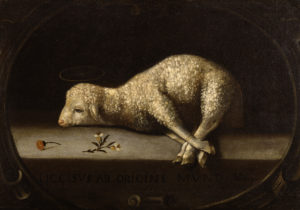“By the blast of God they perish, and by the breath of his nostrils are they consumed.” (Job 4:9 KJV).
These words were spoken by Eliphaz the Temanite to Job. As Job suffers, Eliphaz argues that those who “plow iniquity, and sow wickedness, reap the same,” before adding that they perish “by the blast of God.”
In the late 16th century, this verse was applied to a vastly different context: the defeat of the great Spanish fleet – the Spanish Armada – that attacked England in 1588. As Elesha Coffman recounts in her book, Turning Points in American Church History, the English victory prompted the creation of celebratory models that read, “God blew, and they were scattered,” a reference to Job.
Coffman’s book attempts the tall task of recounting centuries of history in just a few hundred pages. To do this, she elected to pick discrete, illustrative episodes from America’s Christian legacy to tell a broader story. She acknowledges the benefits and drawbacks of this approach, noting historian Mark Noll’s example; by focusing on distinctive turning points, an otherwise inscrutable subject can be rendered intelligible by joining individual facts together into a narrative while delving deeper into those essential events and actions. On the other hand, depth may come at the expense of breadth, leaving certain episodes mentioned passingly or not at all.
Coffman navigates these challenges ably, providing an accessible summary of key events in America’s Christian history and their consequences.
The defeat of the Spanish Armada may seem a peculiar place to begin, seeing as it did not take place in the United States. Yet, as Coffman notes, the victory over the Spanish gave Queen Elizabeth I confidence “that God favored Protestants and would aid them in the future.” She adds, “With a rising power, England, in the Protestant camp, the dream of a reunified Catholic Christendom faded, and imperial control of the New World became an open, and very hotly contested, question.” Spain’s defeat, in other words, shaped colonization, competition for empire, and the religious trajectory of the New World.
Other vignettes highlighted by Coffman offer the reader a longer view of some of the controversial debates that continue to roil the United States today. She includes, for example, a chapter on Roger Williams and religious liberty.
Williams upset the Puritan leaders of Massachusetts for a number of reasons, one of which was his public opposition to the blending of civil and religious authority. From Williams’s perspective, the intermingling of civil and religious authority harmed the church and violated individual conscience. The Bible, he wrote, showed that Jews and early Christians separated from the world, but “when they have opened a gap in the hedge or wall of separation between the garden of the church and the wilderness of the world, God hath ever broke down the wall itself, removed the candlestick, etc. and made His garden a wilderness, as at this day.”
The notion of a “wall of separation” resonates to this day in debates about religious liberty, and the example of Williams illuminates how negotiating the boundaries of church and state has long been embedded in America’s public discourse.
Coffman also explores the rise of evangelicalism in America during the First Great Awakening and the preaching of George Whitefield. Noting that some scholars see the First Great Awakening as a forerunner of the American Revolution due to its democratizing impulses, she cites an episode recounted by historian Thomas Kidd: In 1775, a group of Continental Army soldiers cut pieces from Whitefield’s clothing after stopping at his crypt in Massachusetts before continuing their march.
Moreover, she explores how evangelicalism fit into an early America marked by growth in land and population. Citing historian Catherine Brekus, Coffman writes, “Evangelical faith was personal, portable, and powerful, even when the nearest church was miles away—a common circumstance on the expanding American frontier.”
Fast forward to the early 20th century, and Coffman covers the consequences of the Azusa Street revival for the character of American Protestantism. Over a century after the revival, Pentecostal or charismatic practices imbue much of American Christianity. Coffman refers to a 2022 survey indicating 25 percent of US evangelicals reported speaking in tongues. Today, charismatic denominations permeate the US religious landscape. As political scientist Ryan Burge wrote in 2021, the world’s largest Pentecostal denomination, the Assemblies of God, has continued to grow in the United States even as other denominations have wrestled with decline.
One particularly rich chapter examines the elevation of John Carroll as the first Roman Catholic bishop in the United States in 1789. She writes on the Americanization of Catholicism that took place during his tenure, visible in several ways: Carroll keeping distance from the Vatican, even while acknowledging the pope as head of the church; the emergence of a “congregational parish” with a prominent role for the laity; Carroll’s support for using English in worship; etc.
The 19th century saw Americanization diminish without disappearing. A few years after Carroll’s death, the Archbishop of Baltimore decried democratic impulses among American Catholics, warning of “the artifices of impious priests, who cater to their pride, [and lead Catholics] to believe that they also have the right to elect and dismiss their pastors as they please.” The Catholic hierarchy at home and abroad asserted itself over the century, and waves of immigrants brought their own perspectives on the church that did not necessarily fit with visions of an Americanized Catholicism.
Still, senior clerics remained divided over Americanization even late into the 19th century. Coffman cites the example of a New York-based theological society that was considered “Americanist” and advocated eliminating priestly celibacy, among other views. Pope Leo XIII addressed Americanism directly in an 1899 encyclical that castigated the notion that “the Church should shape her teachings more in accord with the spirit of the age and relax some of her ancient severity and make some concessions to new opinions.”
The chapter prompts reflection on how this history, particularly tensions over Americanization and how to relate to Rome, reverberates among American Catholics today. Hearkening back to Coffman’s example of the New York theological society, one might draw a link to modern liberal US Catholics calling for changes in teachings on marriage, abortion, and other issues. On the conservative end of the spectrum, the irony is that – contra the days of Pope Leo XIII – it is conservative US Catholics who see themselves fighting efforts to shape Catholic teachings “more in accord with the spirit of the age.”
Coffman’s book is an accessible and worthwhile read to understand key inflection points in America’s Christian history. The United States still remains a predominantly Christian country, and Coffman paints a clear and compelling portrait of how we arrived at that point, even if it is not the final word on the subject.







 Sponsor a student for Christianity & National Security 2024
Sponsor a student for Christianity & National Security 2024